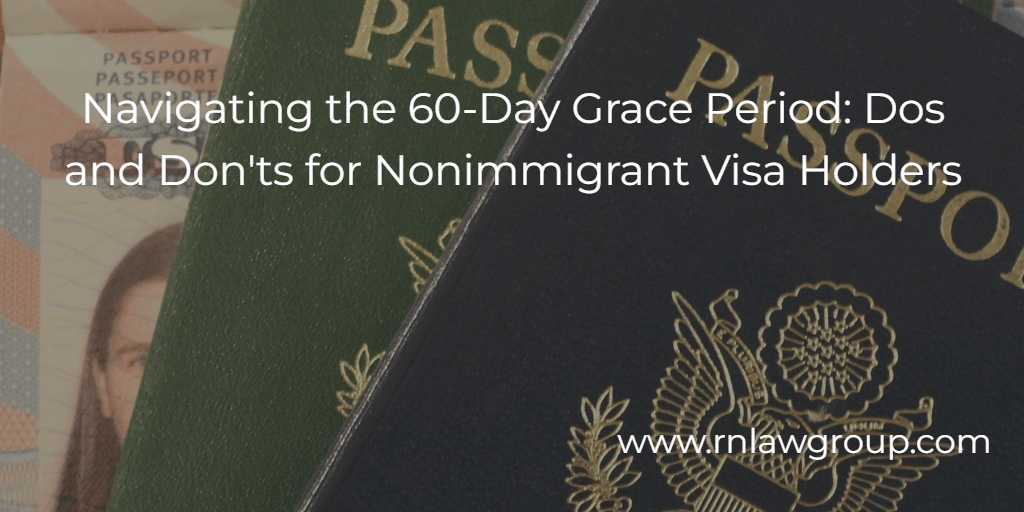
Navigating the 60-Day Grace Period: Dos and Don’ts for Nonimmigrant Visa Holders
The 60-day grace period is a crucial time frame for nonimmigrant visa holders in the United States. When employment or a qualifying event ends, visa holders are granted up to 60 days to either find new employment, change their visa status, or prepare to leave the country. Understanding the intricacies of this period, including what is permissible and what is not, is essential for maintaining legal status in the U.S. This article will delve into the dos and don’ts of the 60-day grace period and highlight a crucial restriction: you cannot travel outside the U.S. and try to re-enter the U.S. during this time.
Understanding the 60-Day Grace Period
The 60-day grace period was introduced as part of the regulations published by the U.S. Citizenship and Immigration Services (USCIS) to provide a cushion for nonimmigrant visa holders. This period acts as a safety net, allowing time to adjust their circumstances without the immediate threat of being out of status. It begins the day after the termination of employment or the end of a qualifying event and extends up to 60 consecutive days or until the expiration of the I-94, whichever is shorter.
The Dos: Making the Most of the 60-Day Grace Period
- Seek New Employment
The primary focus during this period should be to secure new employment if your visa category allows for it. Finding a new employer who is willing to sponsor your visa is crucial. Once you have a job offer, your new employer must file a petition for a new visa on your behalf. Ensure this petition is filed before the grace period ends to avoid any legal complications.
- File for Change of Status
If finding new employment within the 60 days seems unlikely, consider changing your visa status. This could involve switching to a different visa category that better suits your current situation. Common alternatives include an F-1 student visa, B-2 tourist visa, or an H-4 dependent visa (if applicable). Filing the necessary paperwork in a timely manner is essential to maintaining lawful status.
- Prepare to Depart
If securing new employment or changing status isn’t feasible, you should start making arrangements to leave the U.S. within the 60-day period. This proactive approach can help avoid complications associated with overstaying your visa. You can depart on your 60th day, however it is recommend that you depart a few days before your 60th day to avoid any issues with delayed or canceled flights.
- Keep Documentation Ready
Ensure all your documents, such as your latest pay stubs, termination letter, I-797 approval notice, and I-94, are in order. These documents will be necessary for any petitions filed during the grace period.
- Consult with an Immigration Attorney
Navigating the intricacies of immigration laws can be challenging. Consulting with an experienced immigration attorney can provide clarity on your options and help ensure you remain compliant with U.S. immigration laws.
The Don’ts: Pitfalls to Avoid During the Grace Period
- Do Not Delay Action
Time is of the essence during the 60-day grace period. Procrastination can lead to missed deadlines and limit your options. Start job hunting, filing for status changes, or making departure arrangements immediately after the termination of your employment.
- Do Not Violate Your Visa Conditions
Engaging in unauthorized work or activities that violate the terms of your visa can have serious consequences. Ensure that any employment or activities during this period comply with U.S. immigration laws. Always consult an experience business immigration attorney before engaging in other activities or to obtain clarity on what you can and cannot do during this time.
- Do Not Travel Outside the U.S.
One critical restriction during the 60-day grace period is that you cannot travel outside the U.S. Departing the country during this time will invalidate the grace period. If you leave the U.S., you cannot re-enter on the same visa during the grace period, unless you have a new work authorization approval such a new H-1B approval, or a new TN approval. Attempting to return during your 60 day grace period on the same visa and with no employer will lead to serious problems at the port of entry.
- Do Not Ignore USCIS Deadlines
Missing deadlines for filing petitions or applications can result in falling out of status. Pay close attention to all timelines and ensure that all paperwork is submitted on time. Make sure to leave enough time to allow for time for preparation of the new petitions.
- Do Not Assume Automatic Approval
While the 60-day grace period provides a buffer, it does not guarantee that petitions or status changes will be approved. Each application is subject to USCIS review and must meet all relevant requirements. Prepare for contingencies in case your petition is denied.
Conclusion
The 60-day grace period is a valuable provision for nonimmigrant visa holders facing employment termination or the end of a qualifying event. It offers a critical window to secure new employment, change visa status, or prepare for departure. However, navigating this period requires prompt and informed action. Understanding the dos and don’ts, especially the restriction on international travel, is essential for maintaining legal status in the U.S. Attempting to return during your 60 day grace period on the same visa and with no employer will lead to serious problems at the port of entry. By following the guidelines outlined in this article and seeking professional advice when necessary, you can effectively manage this transition period and continue to pursue your goals in the United States.
By: Felipe Jimenez
Felipe Jimenez is an Associate Attorney at Reddy & Neumann, P.C. He works in the Non-Immigrant Visa (NIV) Department where he assists clients through all phases of the non-immigrant visa process.
Reddy & Neumann, P.C. has been serving the business community for over 20 years and is Houston’s largest immigration law firm focused solely on US. Employment-based immigration. We work with both employers and their employees, helping them navigate the immigration process quickly and cost-effectively.

